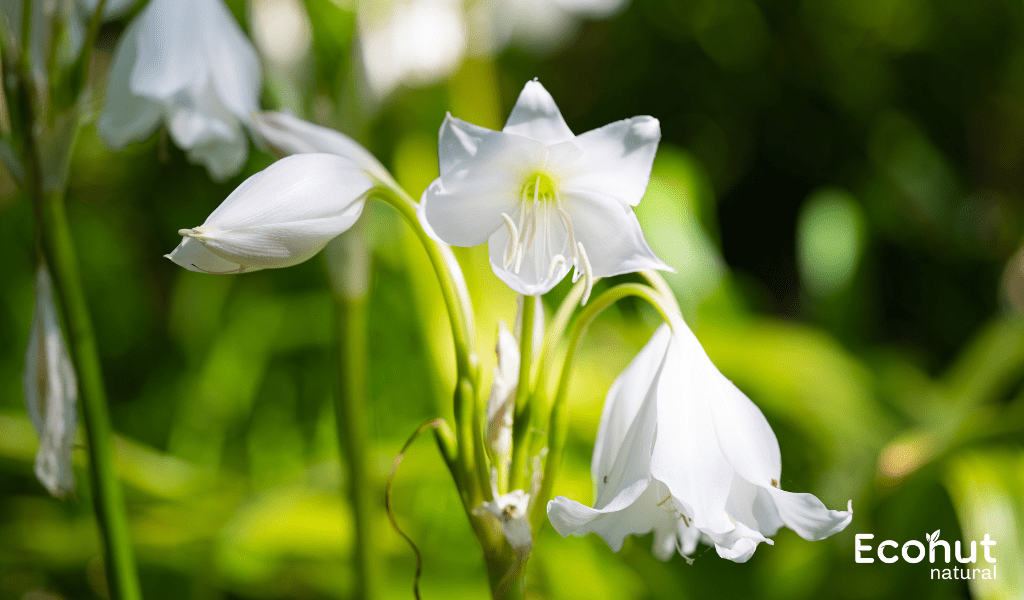A tropical plant known as sudarshana (Crinum latifolium) is found in Asia, South East Asia, Australia, the Pacific Islands, the Caribbean, Florida, and Louisiana. The bulbous plant Sudarsana has lovely bell-shaped white flowers and lance-shaped leaves. The plant appears with leaves and blooms before to the monsoon, but it remains dormant for several months of the year.
The Sudarshana contains over 180 species that belong to a family of exquisite perennial plants. They are also known by other names, such as Spider lilies, Trumpet lilies, Swamp lilies, and so forth, and are useful for gardening, bouquets, and décor.
Description
In Ayurveda, Crinum latifolium is called “Sudarshana” or Sukhdarshan. It indicates that simply by gazing upon it, it bestows upon you happiness and serenity. 5000 BC is when Ayurvedic literature first appeared, and Sushruta mentions Crinum defixum (Kandali). In Ayurvedic medicine, this plant is mostly used to cure skin disorders, poisoning, painful swellings, and unexplained fevers.
Botanical Name:
Crinum latifolium
Family:
Amaryllidaceae
Leave:
Sudarshana is a small plant that grows up to 3 feet contains big green leaves to a length 2-4 inch with 3-4 inch width.
Flowers:
Emerging from the center stalk, the white flowers have a hint of pink. They are grouped in an umbel.
Habitat:
South Asia, South East Asia, Caribbean countries, Australia, Fiji, Philippines, Thailand, Singapore, Malaysia, Louisiana, Florida and other tropical countries.
Parts Used:
- Leaves
- Root
Dosage:
- 3 to 6 grams with hot water, twice daily
Chemical Constituents
The leaves and rhizome of Sudarshana are its valuable parts. Crinum latifolium’s rhizome is primarily composed of Glucans Alkoloids, which include zeylamine, crinofoline, crinofolidine, tazetine, flexinine, harmenthamine, ambelline, and galanthamine.
Sanskrit Synonyms
Somvalli, Chakravaha, Madhuparnika
Morphology
This little plant can reach a height of two to three feet.The leaves are large, reaching 2-4 feet in length and 3–4 inches in width.The rhizome produces leaves that look as though they are sprouting from the earth.The sturdy flowering stems grow to a height of almost two meters.The white flowers with a hint of pink appear from the center stalk and are arranged in an umbel.The round fruits have a diameter of 2 to 2.5 inches and contain 10 to 12 seeds.The plant grows in temperate regions of India, particularly in Central India.
Common forms of Sudarshan
Tablets, Juice, Powder, Capsules
Ingredients
- Indian gooseberry (Emblica officinalis)
- Yavasa (Alhagi camelorum)
- Kutki (Picrorhiza kurroa)
- Pittpapda (Fumaria indica)
- Nagarmotha (Cyperus scariosus)
- Traymana (Gentiana kurroo)
- Netravala (Pavonia odorata)
- Neem (Azadirachta indica)
- Pushkarmool (Inula racemosa)
- Peepal (Ficus religiosa)
- Long pepper root (Piper longum)
- Murva (Chonemorpha macrophylla)
- Giloy(Tinospora cordifolia)
- Carom seeds (Trachyspermum ammi)
- Indrayava (Holarrhena antidysentrica)
- Licorice (Glycyrrhiza glabra)
- Kuda (Hippocampus kuda)
- Haritaki (Terminalia chebula)
- Bibhitaki (Terminalia bellirica)
- Turmeric (Curcuma longa)
- Daruhaldi (Berberis aristata)
- Badi Kateri (Solanum indicum)
- Choti Kateri (Solanum surattense)
- Kachura (Curcuma zeodaria)
- Saunth (Zingiber officinalis)
- Black pepper (Piper nigrum)
- Bharangi (Clerodendrum serratum)
- Moringa/Drumstick plant (Moringa oleifera)
- Purified alum (Potassium alum)
- Vacha (Acorus calamus)
- Cinnamon (Cinnamomum zeylanicum)
- Padmaka (Prunus cerasoides)
- Khas (Chrysopogon zizanioides)
- Devdaru (Cedrus deodara)
- Chavya (Piper retrofractum)
- Patol patra (Trichosanthes dioica)
- Kalmegh (Andrographis paniculata)
- Karanj seeds (Millettia pinnata)
- Cloves (Syzygium aromaticum)
- Sandalwood (Santalum album)
- Atees (Aconitum heterophyllum)
- Kharenti (Sida cordifolia)
- Shalparni (Desmodium gangeticum)
- Prishnaparni (Uraria picta)
- Vaya Vidanga (Embelia ribes)
- Taalispatra (Abies webbiana)
- Nutmeg (Myristica fragrans)
- Tagar (Valeriana wallichii)
- Chitrakmool (Plumbago zeylanica)
- Vanshlochan (Bamboo manna)
- Lotus (Nelumbo nucifera)
- Kakoli (Lilium polyphyllum)
- Tejapatra (Cinnamomum tamala)
Other Language Names of Sudarshana (Crinum latifolium)
Tamil name – Visha Pungil, Vishamungil, Perumanarivingaayam,
Marathi name – Gadambi Kanda
Hindi name – Chinder, Kanwar, Kunwal, Pindar, Barakanwar
Urdu name – Nagdaun
Bengali name – Bada Kanod, Sukha Darshana, Gaerhonar Patta
Telugu name – Kesara Chettu
Philippines name – Lirio
Kannada name – Sudarshana, Visha Mungli
Scientific Classification
| Kingdom | Plantae |
| Clade | Angiosperms |
| Order | Amaryllidaceae |
| Family | Amaryllidaceae |
| Genus | Crinum |
| Species | Crinum latifolium |
Ayurvedic Properties
Rasa (Taste) – Sweet, Bitter (Madhur, Tikt)
Virya (Potency) – Ushana (Hot)
Vipaka (Post Digestion property) – Sweet (Madhur)
Guna (Inherent Properties) – Ruksha, Tikshana (Dry, Pungent)
Sudarshana (Crinum latifolium) Uses
- Ear Infections: Three to five drops of the leaf juice can be injected twice or three times a day to treat ear pain, swelling, or acne inside the ear.
- To prepare oil, crush herbs like ferula narthex (Asafoetida or Hing), ginger, turmeric, basil (Tulsi), garlic, onion, and the leaves of plants like neem and sudarshan. After bringing all the herbs to a boil in water and draining the mixture until just 1/4 of the decoction is left, mix it with the same quantity of oil.
- Scabies and other parasites, such as lice, the leaf juice has potent anti-lice and anti-scabies properties. It can be applied on dandruff by mixing it with a little lemon juice.
- In uncomfortable joints: The leaves can be tied over swellings in cases of rheumatoid arthritis and other inflammatory joints. In the event of osteoarthritis, the juice from the leaves can be combined with castor oil and applied to the inflamed joints. For aching joints, an equal amount of the “Sudarshana Oil” stated above can be used with castor oil.
Sudarshana (Crinum latifolium) Benefits
Sudarshan Benefits for Leucorrhoea:
White water issues are common in women, and they can also cause weakness. In this instance, using sudarshan is really advantageous. Relieving the pain caused by the release of white water can be achieved by grinding the stem of Sudarshan in milk and drinking it immediately.
Sudarshan to Treat Leprosy:
Leprosy can be effectively dried with the use of sudarshan (Crinum latifolium). Grind the root of Sudarshan in the same amount of Chakramard Seed and Cumin, and then apply the paste to relieve Leprosy and itching.
Sudarshan Heals Abscess:
If the previous wound isn’t drying up, powder Sudarshan’s tuber and apply it to the wound or abscess.
Don’t miss: Bhanga (Cannabis Sativa) – Uses, Dose, Benefits & Side Effects
Sudarshana (Crinum latifolium) Side Effects
Common side-effects:
Vomiting and cramping in the abdomen might result from consuming too much leaf juice.
Moms who are nursing or pregnant:
Not enough information to determine a safe dosage. Steer clear of it.
Warning:
Don’t take without first consulting.
Conclusion
Don’t take without first consulting.The leaves of Sudarshana are ground into a paste and administered on eczema and fungal infections. In cases of severe poisoning, 10 milliliters of fresh Crinum latifolium leaf juice is used to cause vomiting and purging.
FAQS
What is Crinum latifolium’s advantage?
Pharmacological effects of Crinum latifolium Linn include anti-inflammatory, anti-diarrheal, hypoglycemic, antioxidant, hepatoprotective, antipyretic, and antimicrobial activities. It also demonstrates antibacterial, anticancer, anti-ulcer, antisecretory, hepatoprotective, hypoglycaemic, and wound healing properties.
What is the purpose of Crinum in medicine?
In Southeast Asian and Thai traditional medicine, Crinum asiaticum L. has long been utilized as a pain reliever and inflammatory illness treatment.
What is Crinum latifolium’s common name?
In Ayurveda, Crinum latifolium is referred to as “Sudarshana” or Sukhdarshan.

